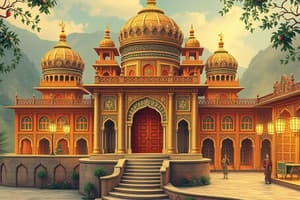Podcast
Questions and Answers
The Taj Mahal was built by the Muslim emperor Shah Jahan of ______.
The Taj Mahal was built by the Muslim emperor Shah Jahan of ______.
India
Mumtaz Mahal died in ______ shortly after giving birth to their fourteenth child.
Mumtaz Mahal died in ______ shortly after giving birth to their fourteenth child.
1631
The Taj Mahal holds a tomb, mosque, rest house, elaborate garden, and ______.
The Taj Mahal holds a tomb, mosque, rest house, elaborate garden, and ______.
arched gateway
For how many years did it take to complete the Taj Mahal? ______ years.
For how many years did it take to complete the Taj Mahal? ______ years.
Mumtaz Mahal encouraged Shah Jahan to perform acts of charity towards the ______.
Mumtaz Mahal encouraged Shah Jahan to perform acts of charity towards the ______.
Mumtaz Mahal earned the love and admiration of the Indian ______.
Mumtaz Mahal earned the love and admiration of the Indian ______.
What is considered one of the world’s most beautiful buildings? The ______ Mahal.
What is considered one of the world’s most beautiful buildings? The ______ Mahal.
The Taj Mahal was built to house the grave of Shah Jahan's beloved ______.
The Taj Mahal was built to house the grave of Shah Jahan's beloved ______.
The Taj Mahal was built with the help of artisans from India, Persia, the Ottoman Empire, and ______.
The Taj Mahal was built with the help of artisans from India, Persia, the Ottoman Empire, and ______.
Where is the Taj Mahal located? ______, India.
Where is the Taj Mahal located? ______, India.
Flashcards are hidden until you start studying
Study Notes
Geography
- The Himalayas are a major landform in Nepal and Bhutan, forming a significant geographical barrier.
- They influence India's climate by impacting monsoon patterns.
Economy
- Agriculture predominates in Nepal, with clothing and carpet production becoming increasingly significant.
- Sri Lanka has seen industrialization while maintaining a strong agricultural sector.
- The Maldives relies heavily on tourism as its primary industry.
Culture
- Bhutan's art and culture are profoundly influenced by Buddhism, shaping local traditions and practices.
Historical Context
- Many South Asian countries have their roots in ancient civilizations yet gained independence relatively recently.
Additional Concepts
- Cottage industries in India produce various goods in local settings, contributing to the economy.
- Hinduism organized India’s society into a caste system, which is a social class based on ancestry.
Definitions
- Caste: A social class based on a person’s ancestry.
- Monsoon: A seasonal wind that significantly affects weather patterns in the region.
- Dzong: A Buddhist center for prayer and study.
- Green Revolution: A government initiative using modern farming methods.
- Pesticide: A chemical used to kill insects, crucial for agricultural practices.
Studying That Suits You
Use AI to generate personalized quizzes and flashcards to suit your learning preferences.




